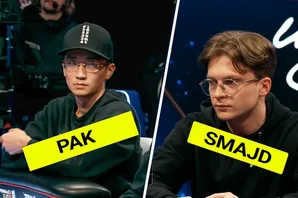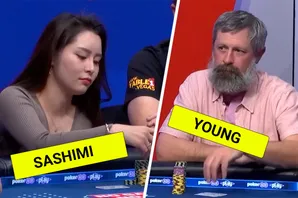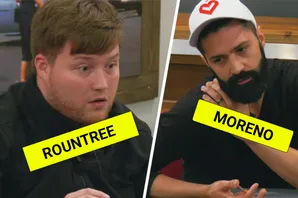In poker games, the big blind is a mandatory bet placed by one player in each betting round. At the start of each round, the big blind position rotates around the table so at some point every player will have their turn to make this forced bet. The big-blind bet helps make the game more interesting.
Whether you play at casinos, in poker tournaments, or in informal cash games, it’s important to be familiar with big blinds (and a few other common terms and poker rules). You’ll hear about big blinds frequently, and there’s a lot to know about this bet.
We’ll cover all the nuances of the big blind below to get you up to speed in just a couple minutes.
Understanding the role of the big blind in poker
Here are a few tips to help you understand why we use blinds in poker.
What is the point of the big blind?
Without mandatory betting, poker games take a long time to build up to exciting stakes. Players may feel reserved about their bets at first, and it can take a few rounds for the pot to grow big enough to catch everyone’s interest and make for an engaging game.
Mandatory blind bets like the small blind and the big blind keep things interesting by making players feel more competitive. And we all feel just a little (or a lot!) more competitive when we’ve already risked some of our money.
Some poker games have other kinds of mandatory bets like antes, but in two of the most popular poker games — Texas Hold’em and Omaha — big blinds and small blinds are the go-to ways to increase the pot.
How is the big blind determined?
There are different ways to determine the amount of the big blind, depending on whether you’re in an individual poker game or a tournament.
For a single game, the big blind is simply the minimum bet for the table.
For tournament play, there’s some nuance to determining the size of the big blind. However, in most cases, poker tournament organizers decide on blind structure based on how long the tournament should last and how many starting chips each player will have.
In tournaments, the big-blind bet increases over time. The duration of a blind level is called the blind period. The big blind in the first betting round will be relatively low compared to its size in the final round of betting.
What’s the difference between a “blind” and a “bet”?
In any game of poker, the difference between a blind and a bet comes down to choice.
Blinds
Blinds like the big blind and small blind are mandatory and are played pre-flop — before the poker players look at their cards. Each player plays the blinds in turn, regardless of the quality of their hand.
Bets
Poker bets are based on strategy rather than on obligation. Players place bets post-flop, not pre-flop as with blinds. With bets, the players choose how much to wager based on how much confidence they have in their cards or on their bluffing strategy. (Remember: blind amounts aren’t left up to player choice.)
Big blind strategy
Let’s look at the best strategy for handling the big blind.
Who gets the big blind in poker?
In the first round, the player two seats to the left of the dealer button plays the big blind, while the player to the immediate left of the dealer plays the small blind. The small blind and the big blind rotate around the table from round to round, so at some point, each player will play the small blind and the big blind.
Blinds in heads-up play
If you’re playing a heads-up poker game, then there are only two players, so the big blind and small blind function a little differently.
In heads-up play, the button and the small blind fall to the same player at the same time. In the first round of a heads-up game, the button posts the small blind and the other player posts the big blind. The button plays first pre-flop and last post-flop. The players switch positions from round to round so each player takes a turn being the button/small blind and a turn being the big blind.
How do you play the big blind?
Many new poker players are wary of playing the big blind. The idea of mandatory betting can be overwhelming, especially in later tournament rounds when the big blind value goes up significantly.
If you’re worried about feeling like you’re throwing your money away, here are a few ideas to help you use the big-blind position to your advantage.
Don’t take other player’s moves personally
At the end of the day, poker is all about winning the pot. But all the other players have as much desire to win as you do. Once you’ve played the big blind, that money belongs to the pot, not you. Other players may raise to make a play for the pot and that’s okay. You’ll do the same thing in future rounds.
Stay in as long as you can
If you played the big blind, but your pre-flop cards aren’t inspiring confidence, you may be tempted to fold early to keep your losses to a minimum. Think through your choices before you decide to fold. Sometimes staying in through the river, or at least the turn, is a small investment while you wait for some better cards.
Keep your head in the game
Some poker players deliberately try to rattle their opponents by consistently raising against the big blind. It’s important to take stock of your cards and make a decision on whether to call, raise, or fold based on your odds of winning, not based on another player’s bluff or swagger.
Calculating pot odds from the big blind
Playing the big blind is challenging for poker players of all experience levels. Fortunately, the key to succeeding at poker is understanding your odds of winning based on consistent and straightforward mathematical calculations.
What are pot odds?
Pot odds are a ratio for how much money is currently in the poker pot vs how much money you’ll need to risk to stay in the game. Some players prefer to think of pot odds in the ratio format while others like to think of them as a percentage. To get pot odds, divide the pot by the amount of your bet.
Pot odds example
If the pot currently has $100 in it and you need to bet $50 to call, then your pot odds would be 2:1. You just divide the total pot value by your needed bet to determine the pot odds.
What to do with pot odds
Once you figure out the pot odds, you need to decide how likely you are to win based on the potential value of your hand. If you hold a hand with a lower rank and your pot odds aren’t great, then it’s a good idea to fold and save your money for a later round, even if you were the big blind.
If you’re sitting on a royal flush and the pot odds are great, then calling or even raising is a no-brainer.
The key to mastering pot odds from the big blind is staying focused and being realistic about your implied odds, especially when blind levels increase each round.
The Takeaway
You may need to take some time playing in low-stakes games to get comfortable with the position of big blind. In fact, many professional poker players loathe being big blind even after becoming masters of the game.
Just like with any new poker skill, practice is the most important step. Don’t shy away from the big-blind position next time you sit down at a poker table. Find a friendly, low-minimum table, and be ready to lose a bit of cash to gain plenty of experience and hone your strategy.
Practice calculating your pot odds by paying attention to how other players handle the big-blind position. Armed with this knowledge and experience, you’ll be able to make strategic decisions rather than emotional ones whenever possible.
Featured image source: Flickr by Poker Photos used under CC license



























